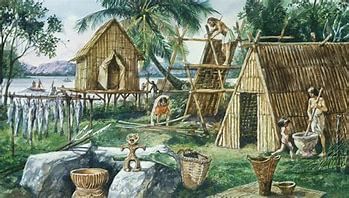UPSC Daily Current Affairs- 29th February 2024 | Current Affairs & Hindu Analysis: Daily, Weekly & Monthly PDF Download
GS-I
Neolithic Period
Subject: Ancient History

Why in News?
Researchers recently un0earthed an ancient burial site of a child with a pot beside it likely dating back to the Neolithic period, at Chettimedu Pathur near Chennai.
About Neolithic Period:
- Definition and Timing:
- The Neolithic Period, or New Stone Age, marks the final stage of prehistoric human cultural and technological development.
- It is primarily associated with the introduction of agriculture, including cereal cultivation and animal domestication.
- The Neolithic era falls within the Holocene Epoch, spanning approximately the last 11,700 years of Earth’s history.
- Generally believed to have begun around 10,000 BCE.
- Transition and Preceding Periods:
- Follows the Paleolithic Period, characterized by chipped-stone tools, and precedes the Bronze Age, known for early metal tools.
- The Neolithic Revolution, heralding the adoption of farming, started in the Fertile Crescent region.
- Features of the Neolithic Age:
- Characterized by polished or ground stone tools, reliance on domesticated plants and animals, settled village life, and the emergence of crafts like pottery and weaving.
- Houses were typically constructed from mud and reed, in rectangular or circular shapes.
- Introduction of alcohol production and early architectural and decorative practices.
- Social Aspects:
- Neolithic tombs containing elaborate pottery and carved jades indicate belief in the afterlife and the emergence of social classes.
- These status objects were reserved for important and wealthy individuals.
- End of the Neolithic Age:
- Transition to the Bronze Age marked by the introduction of copper metallurgy, leading to the production of bronze tools and weapons.
- Stone technology gradually became obsolete.
- Neolithic Sites in India:
- Important Neolithic sites in India include Burzahom in Kashmir, Chiron in Bihar and Uttar in Andhra Pradesh, and Edakkal caves in Kerala.
Source: Indian Express
GS-II
National Commission for Backward Classes (NCBC)
Subject: Polity and Governance

Why in News?
The National Commission for Backward Classes (NCBC) has raised serious objections to the West Bengal government’s recommendation to include 83 castes in the central list of Other Backward Classes (OBCs).
About National Commission for Backward Classes (NCBC):
- Establishment and Constitutional Status:
- NCBC was initially established under the National Commission for Backward Classes Act, 1993, by the Central Government.
- Gained constitutional status through the Constitution (One Hundred and Second Amendment) Act, 2018, with the addition of Article 338B.
- Composition:
- Comprises a Chairperson, a Vice-Chairperson, and three Members.
- All members hold the rank and pay equivalent to a Secretary to the Government of India.
- Appointment is made by the President.
- Functions:
- Monitor and investigate matters related to safeguards for socially and educationally backward classes.
- Address specific complaints regarding their rights.
- Participate in and advise on socio-economic development.
- Present reports to the President on the efficacy of safeguards.
- Make recommendations for effective implementation of measures.
- Discharge other functions specified by the President.
- Powers:
- Quasi-judicial powers, enabling it to summon individuals, request documents, and receive evidence on affidavits.
- Power to regulate its own procedures.
- Mandated consultation by Union and State Governments on major policy matters affecting backward classes.
Source: Economic Times
Row over Karnataka Temple Bill
Subject: Polity

Why in News?
The Karnataka government’s recent move to amend the law governing the taxation of Hindu temples sparked significant debate and controversy.
- It aims to overhaul the existing framework, particularly in terms of income allocation and management.
The Karnataka Hindu Religious Institutions and Charitable Endowments (Amendment) Bill, 2024 aimed to modify several provisions in the existing law:
- Income Allocation: The proposed change sought to divert 10% of the gross income of temples earning over Rs 1 crore annually to a common pool for temple maintenance. Section 19 of the Act outlines the purposes for which the common fund may be utilized, including religious studies, temple maintenance, and charitable causes.
- Shift in Calculation: This change would shift from the previous norm of allocating 10% of the net income of temples with earnings over Rs 10 lakh annually.
- Dedicated Common Pool: Additionally, 5% of the income of temples earning between Rs 10 lakh and Rs 1 crore annually would have been dedicated to the common pool.
- Priests Welfare: The Congress government proposed utilizing the enhanced funds to support lower-income temples, provide assistance to ailing priests, and offer scholarships to priests’ families.
- Committee of Management: The Bill proposed including a member skilled in Vishwakarma Hindu temple architecture and sculpture within the committee of management for temples.
- Authority of Rajya Dharmika Parishat: It granted the Rajya Dharmika Parishat the power to appoint the chairman of temple management committees.
- Infrastructure Oversight: The Bill mandated the creation of district-level and state high-level committees to oversee infrastructural projects facilitating temple pilgrimage.
- Interference into Religious Matters: BJP leaders accused the government of attempting to “rob” Hindu temples and questioned the selective targeting of Hindu institutions.
- Questioning Motives: Concerns were raised regarding the selective taxation of Hindu temples, prompting questions about the government’s intentions.
- Telangana’s Model: Similar to Karnataka, Telangana also mandates temple contributions towards a common good fund, utilized for temple maintenance and related expenses.
- Kerala’s Devaswom Boards: Kerala’s temples are managed by state-run Devaswom Boards, each with its own budget and administrative laws, overseen by government-appointed nominees.
- Government Interference: The appointment of members from Hindu and other religions to temple management committees raises concerns about state involvement in temple affairs.
- Contradiction to Secularism: Perceived as contradicting the principle of secularism advocating for a separation of religion and state involvement in religious matters.
- Conflict with Autonomy: Opposition to the diversion of temple income for a common pool fund highlights concerns about encroachment on religious autonomy and financial mismanagement by the state.
- The Karnataka temple bill controversy underscores the complex interplay between governance, religion, and finance.
- While intended reforms aimed to enhance temple infrastructure and support, differing interpretations and political alignments led to its rejection.
- As states grapple with temple management, a balance between tradition, governance, and public welfare remains a constant challenge.
Source: Indian Express
GS-III
Kasu Brahmananda Reddy National Park
Subject: Environment

Why in News?
Hyderabad Nizam’s personal petrol pump was found inside KBR National Park
Background:-
- The revelation sheds light on the park’s rich history.Previously under the possession of the Nizam of Hyderabad, the area was later acquired by the government under the Urban Land Ceiling Act. However, a portion of 2.40 hectares was permitted to be retained by the Nizam.
About Kasu Brahmananda Reddy National Park:-
- Kasu Brahmananda Reddy National Park is a national park located in Jubilee Hills and Banjara Hills in Hyderabad, Telangana, India.
- The park provides an excellent lung space and environment from the busy city life and rising pollution levels.
- Some of the animals making their home in the park include: pangolin, small Indian civet, peacock, jungle cat and porcupines.
- It was declared as a National park by the Andhra Pradesh state government after getting approval from the central government in the year 1998.
- Other national parks in Telangana state are Mahavir Harina Vanasthali National Park and Mrugavani National Park.
Source: Telegana Today
The Raman Effect
Subject: Science and Technology

Why in News?
February 28th is celebrated as national science day
Background:
- In 1986, the Government of India, under then Prime Minister Rajiv Gandhi, designated February 28 as National Science Day to commemorate the announcement of the discovery of the “Raman Effect”.
About Raman Effect
- While passing through the Mediterranean Sea, Raman was most fascinated by the sea’s deep blue colour. Dissatisfied with the then-accepted answer (“the colour of the sea was just a reflection of the colour of the sky”), his curious mind delved deeper.
- He soon found out that the colour of the sea was the result of the scattering of sunlight by the water molecules.
- Fascinated by the phenomenon of light-scattering, Raman and his collaborators in Calcutta began to conduct extensive scientific experiments on the matter – experiments that would eventually lead to his eponymous discovery.
- Simply put, the Raman Effect refers to the phenomenon in which when a stream of light passes through a liquid, a fraction of the light scattered by the liquid is of a different colour. This happens due to the change in the wavelength of light that occurs when a light beam is deflected by molecules.
- In general, when light interacts with an object, it can either be reflected, refracted or transmitted.One of the things that scientists look at when light is scattered is if the particle it interacts with is able to change its energy. The Raman Effect is when the change in the energy of the light is affected by the vibrations of the molecule or material under observation, leading to a change in its wavelength.
- In their first report to Nature, titled “A New Type of Secondary Radiation,” CV Raman and co-author KS Krishnan wrote that 60 different liquids had been studied, and all showed the same result – a tiny fraction of scattered light had a different colour than the incident light. “It is thus,” Raman said, “a phenomenon whose universal nature has to be recognised.”
- CV Raman’s discovery took the world by storm as it had deep implications far beyond Raman’s original intentions. As Raman himself remarked in his 1930 Nobel Prize speech, “The character of the scattered radiations enables us to obtain an insight into the ultimate structure of the scattering substance.”
- The discovery would also find its use in chemistry, giving birth to a new field known as Raman spectroscopy as a basic analytical tool to conduct nondestructive chemical analysis for both organic and inorganic compounds.
- With the invention of lasers and the capabilities to concentrate much stronger beams of light, the uses of Raman spectroscopy have only ballooned over time.
- Today, this method has a wide variety of applications, from studying art and other objects of cultural importance in a non-invasive fashion to finding drugs hidden inside luggage at customs.
Source: Indian Express
Seaweed
Subject: Environment

Why in News?
Recently, the National Conference on the Promotion of Seaweed Cultivation was held in Koteshwar (Kori Creek), Kutch, Gujarat.
Background:
- It’s a first national conference on seaweed cultivation which is an alternate for employment generation of seaweed products as it diversifies marine production and its opportunities for enhancing fish farmer income, reduces reliance on traditional fishing, and diversifies coastal communities’ livelihoods.
What are Seaweeds?
- The Seaweeds are macroscopic, multicellular, marine algae. They come in a variety of coluors, including red, green, and brown.
- They are referred to as the ‘Medical Food of the 21st Century’.
- Seaweeds are found mostly in the intertidal region, in shallow and deep waters of the sea, and also in estuaries and backwaters. Large seaweeds form dense underwater forests known as kelp forests, which act as underwater nurseries for fish, snails, and sea urchins.
- India boasts approximately 844 reported seaweed species in its seas. Some specific species, such as Gelidiella acerosa, Gracilaria spp., Sargassum spp., Turbinaria spp., and Cystoseira trinodis are cultivated for the production of agar, alginates, and liquid seaweed fertilizer.
- Abundant seaweed resources are found along the Tamil Nadu and Gujarat coasts, as well as around Lakshadweep and the Andaman & Nicobar Islands. Notable seaweed beds exist around Mumbai, Ratnagiri, Goa, Karwar, Varkala, Vizhinjam, and Pulicat in Tamil Nadu, Andhra Pradesh, and Chilka in Orissa.
Significance:
- Seaweeds act as bio-indicator by absorbing excess nutrients and signalling marine chemical damage caused by waste from agriculture, industries, and households, often leading to algal blooming.
- They play a vital role in restoring ecosystem balance.
- Seaweed is a nutritional powerhouse, rich in vitamins, minerals, and dietary fibre.
- It is used in various food products, from sushi and salads to snacks and thickeners.
- Many seaweeds contain anti-inflammatory and anti-microbial agents. Seaweed is the best source of iodine.
- Seaweed extracts are used in a wide range of products, including cosmetics, pharmaceuticals, and bioplastics. They offer sustainable alternatives to conventional options.
- Seaweed absorbs carbon dioxide from the atmosphere as it grows, making it a potential tool in the fight against climate change. Studies suggest cultivating and sinking seaweed could effectively store long-term carbon.
- Seaweed farming provides income and empowers coastal communities, particularly women and small-scale farmers. It requires minimal investment and offers relatively quick returns.
- Seaweeds are utilized for various purposes, including laxatives, pharmaceutical capsules, goiter treatment, cancer therapy, bone replacement, and cardiovascular surgeries.
Government initiatives regarding Seaweed:
- Seaweed Mission aims to commercialize seaweed farming and processing for value addition. It also aims to increase cultivation along India’s7,500-kilometer coastline.
- TheIndian Council of Agricultural Research (ICAR)- Central Marine Fisheries Research Institute (CMFRI) has successfully commercialized two seaweed-based nutraceutical products, CadalminTM Immunalgin extract (CadalminTM IMe) and CadalminTM Antihypercholesterolemic extract (CadalminTM ACe). These products, developed with eco-friendly ‘green’ technology, aim to boost anti-viral immunity and combat high cholesterol or dyslipidemia (imbalance of cholesterol).
- Multi-Purpose Seaweed Parkhas been established in Tamil Nadu.
Infrastructure Investment Trusts (Invits)
Subject: Economy

Why in News?
The initial public offering (IPO) of Bharat Highways Infrastructure Investment Trusts (InvITs) was subscribed 22% on the first day of the bidding process.
Background:
- The Bharat Highways InvIT is established with the goal of acquiring, managing, and investing in a diversified portfolio of infrastructure assets across India.
About INFRASTRUCTURE INVESTMENT TRUSTS (INVITS):
- InvITs function as collective investment schemes, akin to mutual funds.
- The primary purpose of InvITs is to pool funds from individual and institutional investors for direct investment in infrastructure projects.
- Investors receive a portion of the income generated by these projects as returns.
- The returns from InvITs come in the form of dividends, interest, and capital gains.
- Interest income from deposits in Infrastructure Investment Trusts (InvITs) is exempted from tax. However, it’s important to note that the dividends and capital gains received by investors are taxable.
- InvITs offer investors partial ownership in infrastructure projects.
- InvITs are regulated by the Securities and Exchange Board of India (SEBI).
- Infrastructure Investment Trusts (InvITs) are recognized as borrowers under the ‘Securitization and Reconstruction of Financial Assets and Enforcement of Security Interest Act, 2002’. This recognition allows InvITs to raise funds by issuing units to investors and invest in infrastructure projects. The Act provides a legal framework for the securitization and reconstruction of financial assets, ensuring transparency and investor protection.
- Any Infrastructure Development Company can take the role of the sponsor to form an InvIT.
- The sponsor establishes a trust, often in the form of a special purpose vehicle (SPV), to hold the infrastructure assets.
- The trust is managed by professionals, relieving investors of project management responsibilities.
Source: Live Mint
|
63 videos|5408 docs|1146 tests
|
FAQs on UPSC Daily Current Affairs- 29th February 2024 - Current Affairs & Hindu Analysis: Daily, Weekly & Monthly
| 1. What is the significance of Neolithic Period in the history of human civilization? |  |
| 2. What is the role of the National Commission for Backward Classes (NCBC) in India? |  |
| 3. What is the controversy surrounding the Karnataka Temple Bill? |  |
| 4. What are some key features of the Kasu Brahmananda Reddy National Park in India? |  |
| 5. How do Infrastructure Investment Trusts (Invits) contribute to infrastructure development in India? |  |
















